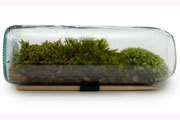You may not know it but there are predators in your neighborhood. They may be in your backyard, your local park or even in your schoolyard! Who are these assailants? They're plants!
Poisonous Plants - Poison Ivy and Poison Oak
What It Is: Both Poison Ivy and Poison Oak are variations of a North American plant that causes skin irritation to most people who touch it. The two plants are closely related but Poison Ivy is a vine and Poison Oak is a shrub.
How it Attacks: Both of these plants are covered in a poisonous irritant called urushial. About three out of every four people are allergic to urushial so they get a rash, blisters, itching and swelling that can last for a few days to a few weeks.
What it Looks Like: It will look like a vine or a shrub that has small green flowers, three leaflets and off-white berries. Stay away from dead plants too - the urushial can remain active for up to five years after the plant has died.
How to Treat It: Shower as soon as you can after coming in contact with these plants. The urushial oil is still active on your skin and you can transfer it to other places (and other people)! A lot of peeps recommend showering a few times and using a dish detergent instead of regular soap. Make sure to wash the clothes you were wearing a few times too. It's also a good idea to wash all bedding and clothes after each time you use them until the rash goes away. Ask your doctor about taking anti-allergy medication to help ease your recovery.
Poisonous Plant - Stinging Nettle
What It Is: A broad leafed plant that lives in western North America and parts of Europe, which causes a stinging rash when touched.
How it Attacks: This plant has hollow hairs on the underside of its leaves, on its stem and on the veins along the top part of its leaves. When you brush past the plant, these tiny hairs break off in your skin and release formic acid into your skin. This causes a stinging sensation, as well as redness, white bumps and itchiness that can last up to 24 hours.
What it Looks Like: Stinging Nettles grow in shady areas. They have a straight, tall stem and heart-shaped leaves. In spring, tiny clusters of greenish flowers form where the leaves and stem meet.
How to Treat It: Curled Dock plants live in the same areas that Stinging Nettles do. They are short, broad leafed plants that sort of look like overgrown Dandelions, but without the flower part. If you pick of one of their leaves and rub it on the affected area, you'll get a little relief. Also, if you are close to home you can rub a paste of baking soda and water on it, which should make you feel better.
Poisonous Plant - Deadly Nightshade
What It Is: This plant is also known as Belladonna. It grows in parts of Europe and Asia. It's technically a herb, but you don't want to sprinkle this on your pizza.
How it Attacks: Deadly Nightshade contains poisons that, when eaten, can cause damage to your nervous system, send you into a coma and even death! Thankfully, this plant has to be consumed to do damage to you, so you're safe as long as you don't eat it. So don't eat it!
What it Looks Like: The Deadly Nightshade is short with a purplish base. It has dark green leaves of various sizes and it has purplish, bell-shaped flowers in the summer. It also has berries that look a little like cherries.
How to Treat It: The best way to prevent getting sick or dying from an encounter with this plant is not to eat any part of it. If, for some reason, someone does eat some of this plant, you need to make the person throw up and take them to the hospital right away.
*Note: It's a good rule of thumb to never eat any plants while you're out hiking. This is not a buffet; it's nature!
Related Stories:
- Take a Hike
- Biomes of the World - Forests
- Surviving the Elements - From Bugbites to Sunburn
- More Wild Science

































